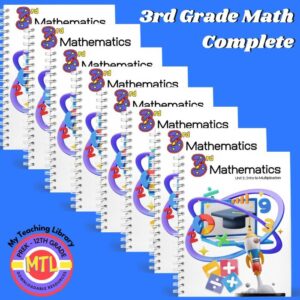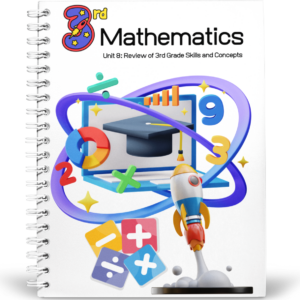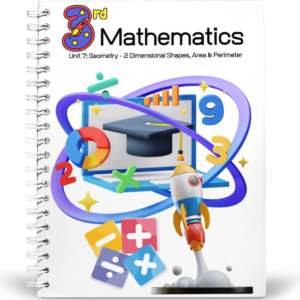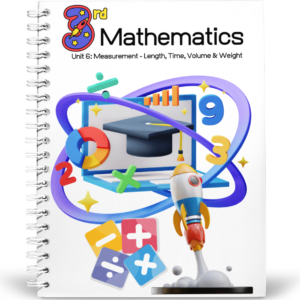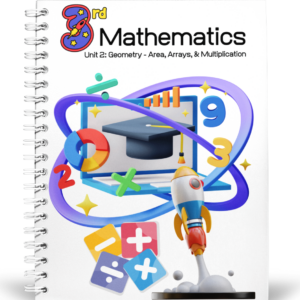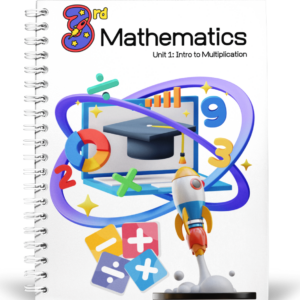Category: Curriculum
- Home
- /
- Shop
- /
- By Subject
- /
- Math
- /
- Curriculum & Textbooks
- /
- 3rd Grade
- /
- Curriculum
Showing all 9 resultsSorted by latest
-
Sale!Buy Now
$40.50Original price was: $40.50.$35.00Current price is: $35.00.3rd Grade Math Complete is an 8 unit program that covers all of the important skills and concepts typically covered in 3rd grade. Each unit includes the student and teacher edition. This resource can be used within a classroom setting, co-op or with individual students. Because it can be used within a group setting, you’ll find many activities for students to complete in pairs of 2. If you are homeschooling multiple children close in age, it would be easy to adapt and teach students together. If you are homeschooling a single child, you can easily adapt these activities through your one-on-one interaction!
You do not need to use the entire program if you are only wanting to focus on one or a few specific Math skills and concepts. If this is the case, you can purchase each unit separately.
Units:
- – Unit 1: Intro to Multiplication
- – Unit 2: Geometry: Area, Arrays and Multiplication
- – Unit 3: Reviewing Addition & Subtraction within 1,000
- – Unit 4: Relating Multiplication and Division
- – Unit 5: Fractions – Number Lines, Equivalent & Comparing
- – Unit 6: Measurement – Length, Time, Volume & Weight
- – Unit 7: Geometry – 2 Dimensional Shapes, Area & Perimeter
- – Unit 8: Review of 3rd Grade Skills & Concepts
-
$5.00Buy Now
In this unit, students revisit major work and fluency of 3rd grade math skills and concepts including comparing, adding, and subtracting fractions, multiplying and dividing within 1,000, and using the standard algorithm to add and subtract multi-digit numbers.
Includes: Student and Teacher Editions
Size: 256 pages -
$5.00Buy Now
In this unit, students reason about attributes of two-dimensional shapes, calculate area and learn about perimeter. Students learn to classify broader categories of shapes (quadrilaterals and triangles) into more specific sub-categories based on their attributes. For instance, they study examples and non-examples of rhombuses, rectangles, and squares, and come to recognize their specific attributes. Students also expand their knowledge about attributes that can be measured. In this unit, students learn the meaning of perimeter and find the perimeter of shapes. They consider geometric attributes of shapes (such as opposite sides having the same length) that can help them find perimeter. As the lessons progress, they consider situations that involve perimeter, and then those that involve both perimeter and area. These lessons aim to distinguish the two attributes (which are commonly confused) and reinforce that perimeter measures length or distance (in length units) and area measures the amount of space covered by a shape (in square units). At the end of the unit, students solve problems in a variety of contexts. They apply what they learn about geometric attributes of shapes, perimeter, and area, to design a park, a West African wax print pattern, and a robot. They then solve problems within the context of their design.
Includes: Student and Teacher Editions
Size: 318 pages -
$4.50Buy Now
In this unit, students measure length, weight, liquid volume, and time. They begin with a study of length measurement, building on their recent work with fractions. Students will explore length measurements in halves and fourths of an inch. They use a ruler to collect measurements and then display the data on line plots, learning about mixed numbers and revisiting equivalent fractions along the way. Next, students learn about standard units for measuring weight (kilograms and grams) and liquid volume (liters). To build a sense of weights such as 1 gram or 1 kilogram, students hold common objects such as paper clips and bottles of water. From there, students move on to measure time. In the final section of the unit, students make sense of and solve problems related to all three measurements. The work here allows students to continue to develop their fluency with addition and subtraction within 1,000 and understanding of properties of operations. It also prompts them to use the relationship between multiplication and division to solve problems.
Includes: Student and Teacher Editions
Size: 228 pages -
$5.00Buy Now
In this unit, students will learn about fractions, naming parts, building from units, locating on a number line, equivalent fractions, and how to compare fractions with the same denominator and the same numerator.
Includes: Student and Teacher Editions
Size: 338 pages -
$6.00Buy Now
This unit introduces students to the concept of division and its relationship to multiplication. Previously, students learned that multiplication can be understood in terms of equal-size groups. The expression 5 x 2 can represent the total number of objects when there are 5 groups of 2 objects, or when there are 2 groups of 5 objects. Here, students make sense of division also in terms of equal-size groups. For instance, the expression 30 ÷ 5 can represent putting 30 objects into 5 equal groups, or putting 30 objects into groups of 5. They see that, in general, dividing can mean finding the size of each group, or finding the number of equal groups. Students use the relationship between multiplication and division to develop fluency with single-digit multiplication and division facts. They continue to reason about products of two numbers in terms of the area of rectangles whose side lengths represent the factors, decomposing side lengths and applying properties of operations along the way. As they multiply numbers greater than 10, students see that it is helpful to decompose the two-digit factor into tens and ones and distribute the multiplication. Toward the end of the unit, students solve two-step problems that involve all four operations.
Includes: Student and Teacher Editions
Size: 431 pages -
$5.00Buy Now
In this unit, students work toward the goal of fluently adding and subtracting within 1,000. They use mental math strategies developed in grade 2 and learn algorithms based on place value. Students work with a variety of algorithms, starting with those that show expanded form, and moving toward algorithms that are more streamlined and closer to the standard algorithm. Understanding of place value also comes into play as students round numbers to the nearest multiple of 10 and 100. Students do not need to know a formal definition of “multiples” until grade 4. At this point, it is enough to recognize that a multiple of 10 is a number called out when counting by 10, or the total in a whole-number of tens (such as 8 tens). Likewise, a multiple of 100 is a number called out when counting by 100, or the total in a whole-number of hundreds (such as 6 hundreds). Students use rounding to estimate answers to two-step problems and determine if answers are reasonable.
Includes: Student and Teacher Editions
Size: 374 pages -
$5.00Buy Now
In this unit, students encounter the concept of area, relate the area of rectangles to multiplication, and solve problems involving area. Students make sense of another attribute of shapes: a measure of how much a shape covers. They begin informally, by comparing two shapes and deciding which one covers more space. Later, they compare more precisely by tiling shapes with pattern blocks and square tiles. Students then focus on the area of rectangles. They notice that a rectangle tiled with squares forms an array, with the rows and columns as equal-size groups. This observation allows them to connect the area of rectangles to multiplication—as a product of the number of rows and number of squares per row. To transition from counting to multiplying side lengths, students reason about area using increasingly more abstract representations. They begin with tiled or gridded rectangles, move to partially gridded rectangles or those with marked sides, and end with rectangles labeled with their side lengths. Students also learn some standard units of area—square inches, square centimeters, square feet, and square meters—and solve real-world problems involving area of rectangles. Later in the unit, students find the area and missing side lengths of figures composed of non-overlapping rectangles.
Includes: Student and Teacher Editions
Size: 306 pages -
$5.00Buy Now
In this unit, students ready to learn multiplication will interpret and represent data on scaled picture graphs and scaled bar graphs and then they will learn the concept of multiplication! Students explore scaled picture graphs and bar graphs as an entry point for learning about equal-size groups and multiplication. The idea that one picture can represent multiple objects helps to introduce the idea of equal-size groups. Students learn that multiplication can mean finding the total number of objects in groups of objects each, and can be represented by a x b. They then relate the idea of equal groups and the expression a x b to the rows and columns of an array. In working with arrays, students begin to notice the commutative property of multiplication. In all cases, students make sense of the meaning of multiplication expressions before finding their value, and before writing equations that relate two factors and a product. Later in the unit, students see situations in which the total number of objects is known but either the number of groups or the size of each group is not known. Problems with a missing factor offer students a preview to division.
Includes: Student and Teacher Editions
Size: 369 pages


